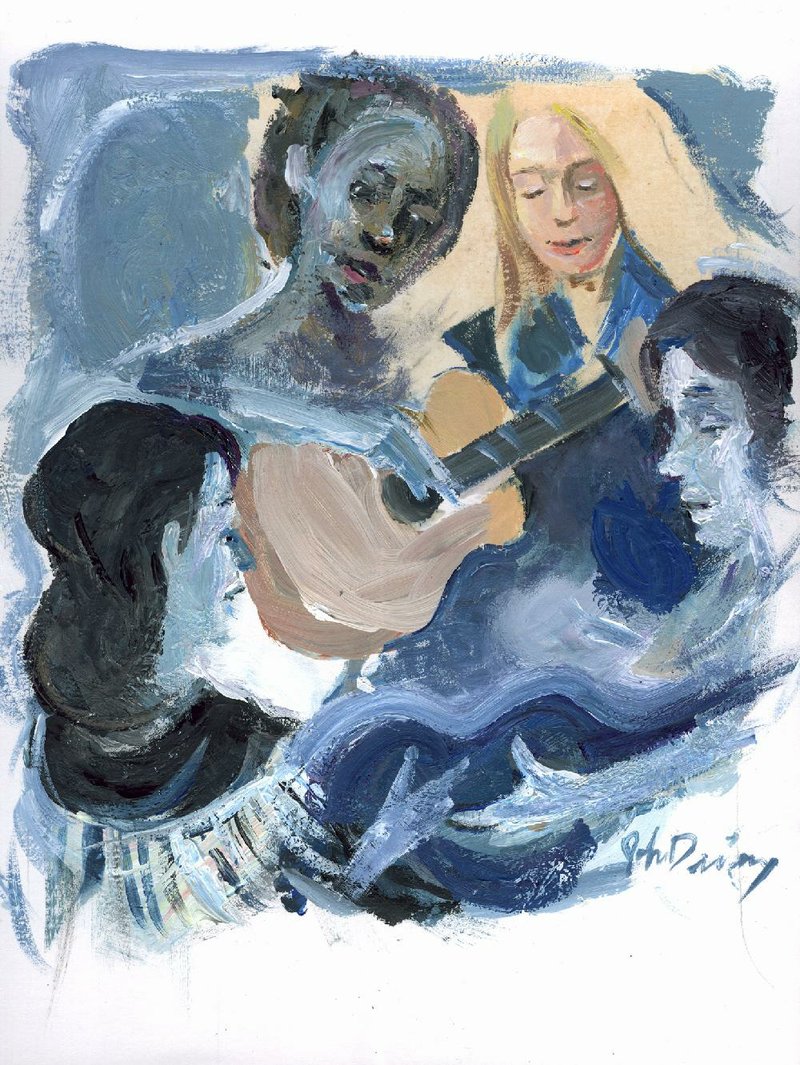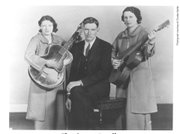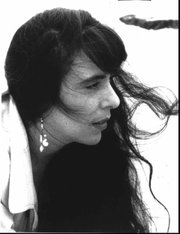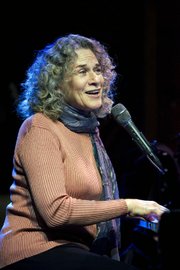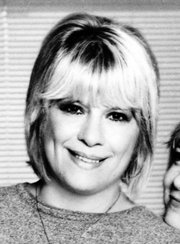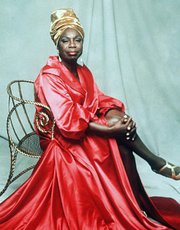Rock 'n' roll is a boys club. That's the critical orthodoxy and the truth.
Much of the reason is the way adolescent males bond with each other; they're so freaked out and nervous around girls that they're happy to have a safe space where they can lie about sex with their buddies. A lot of research papers explore the "homosocial" (same-sex relationships that are not romantic or sexual) and homophobic aspects of rock culture. Most are jargon-riddled acknowledgments that teen boys are hormonal, immature jerks. They form girl-haters clubs.
Which girls generally shrug at.
"I didn't want to jam with anyone, because they were all guys. I missed out on that," Chrissie Hynde told Ted Drozdowski of Premier Guitar magazine earlier this year. ".... I really regret that, because that's where all the fun is and where you can go on a journey with the rest of the band. My excuse is that I was a girl and I never really felt like, you know, wanting to."
Hynde is evidence that despite this, women do wind up in rock 'n' roll bands, and that they can function -- as she has for decades -- as the chief creative engine. Even though there are still those who doubt her musicianship -- Hynde is a ferocious rhythm guitar player who has little interest in shredding leads -- and would minimize her role in The Pretenders. Sure, she's the focal point, the singer and the songwriter, but it's the dudes on stage who throw up the wall of noise.
While Hynde bristles at the implicit misogyny of those sentiments, she's generous enough to acknowledge the important contributions Pretenders' original guitarist James Honeyman-Scott made to their early hits. She's the last original member left. But she considers Alone, the most recent album, a Pretenders record rather than a solo effort. Hynde wrote or co-wrote 11 of its 12 songs, but musically, she's credited only as a vocalist.
Some people were reluctant to give Courtney Love much credit for her band Hole's remarkable second album Live Through This, which was released in 1994, one week after her husband Kurt Cobain's suicide. A lot of people insist Cobain wrote the album's songs, though the band members (and Cobain biographers) have dismissed that as a myth. Sure, the music on the album employs some of the same stop-start, quiet-loud-quiet dynamics that characterize Nirvana's music, but that might be said for a lot of the pop music released in 1994.
The assumption is that female artists are somehow less capable of real musicianship than their male counterparts. Women in rock bands are marginalized as singers; behind every diva is a Svengali of a male producer calling the shots. Conventional histories of pop music admit women reluctantly and with qualifications. They are seen as anomalies.
...
That has more to do with the male gaze and the ways boys form their homosocial packs than any lack of female talent.
The case can be made that the most important guitar player in the history of recorded popular music was "Mother" Maybelle Carter, the sole guitarist and alto harmony singer in The Carter Family, a trio comprised of Maybelle, her cousin Sara and Sara's husband, A.P. Carter.
While The Carter Family nominally performed as a trio, A.P. didn't contribute much. He sang a little and sometimes held a guitar on stage. His role was primarily to find material for the group to record. He was one of the first country artists to understand the importance of copyright; he ended up copyrighting a lot of songs he collected on his "song hunting" trips that he didn't actually write. While that mighn't have been quite ethical -- we know he didn't write "Keep on the Sunny Side," one of The Carter Family's signature tunes -- he probably is responsible for the preservation of songs that had been handed down through an oral tradition.
With A.P. pretty useless as a guitar player, Maybelle was forced to come up with an innovative technique that allowed her to play lead and rhythm parts at the same time. Before Maybelle, the guitar was strictly a rhythm instrument, used almost like percussion, while banjos and fiddles played melodic leads.
This method -- called variously the Carter Scratch, Carter lick, thumb brush and most often Carter Family Picking -- involved Maybelle using her thumb to pick out the melody on the bass strings of her 1928 Gibson L-5 while rhythmically downstroking chords with her other fingers on the treble strings. She usually accomplished this by wearing a thumb pick and a finger pick on her index finger.
As simple as this innovation might seem today, no one had played that way before. So Maybelle Carter has a claim as the mother of modern rhythm and lead guitar styles ... all because the sole guy in the band couldn't pull his instrumental weight.
The Carter Family is incredibly important in other ways. They were the first popular recording group to employ a female lead singer (Sara), they rescued the folk songs of what critic Greil Marcus has called the Old Weird America and furnished us with a common reservoir of tropes and images. Their influence extends far beyond country music; it's impossible to imagine Bob Dylan or Jimi Hendrix without them.
...
There's another Maybelle -- Big Maybelle, born Mabel Louise Smith in 1924 -- whose influence on what we call rock 'n' roll has been largely obscured. Big Maybelle was a precocious gospel singer -- she won a Memphis talent show when she was 8 years old -- who switched to rhythm & blues. By age 12, she was working with Dave Clark's Memphis Band.
The possessor of a gravelly belter's voice, she could modulate with uncanny precision (her tender 1956 hit "Candy" got a second life when it was featured on The Cosby Show in 1986). Big Maybelle was perhaps the most versatile female vocalist of the '50s. She had the power of Big Mama Thornton and something of the elasticity of Billie Holiday (who once refused to follow Maybelle's blistering opening act). She was one of the chief models for Aretha Franklin. Maybelle's 1955 version of "Whole Lotta Shakin' Goin' On" (produced by a very young Quincy Jones) prefigured Jerry Lee Lewis' raucous take two years later. (Maybelle's is a good deal racier.) Few records of the era rock harder than the sides she cut for Savoy in the late '50s: "Ring Dang Dilly," "That's a Pretty Good Love" and "Tell Me Who."
Big Maybelle is largely forgotten today, although her name sometimes turns up on lists of artists overlooked by the Rock and Roll Hall of Fame. That's due in part to her early death at 47 -- she had substance abuse problems -- but she was also a victim of the whitewashing practices of the '50s when her best work was relegated to black radio and distribution networks.
Mississippi-born, Memphis-based Cordell Jackson became the first woman to produce, engineer, arrange and promote music on her own music label, Moon Records, which she founded in 1956 after working for Sam Phillips at Sun Records. When Phillips wouldn't give her a chance to make her own records, she started Moon, which operated until her death in 2004. She's probably best known for a series of shtick appearances as the "rock 'n' roll granny" on TV talk shows and a 1990 Bud Light commercial with Brian Setzer.
Aside from prominent figures like Brenda Lee and Wanda Jackson, the '50s saw a slew of raw, powerful female rockabilly artists like Janis Martin, who was signed to RCA Records in March 1956, two months after Elvis Presley. She became known as the "female Elvis." (Her parents vetoed an offer from Col. Tom Parker for her to tour with Presley; they elected to send her out as part of a Jim Reeves tour.)
Another overlooked female progenitor was Bonnie "Guitar" Buckingham. Born in Seattle in 1923, Buckingham had some success with her band the K-6 Wranglers, scoring a regional hit with her first single "The Two-Timin' Yodeler" in 1948 by her band.
In 1957 she recorded "Dark Moon," which defined the trajectory of her career. Her producer Fabor Robison tried dozens of arrangements of the track, some with as many as 12 musicians, but couldn't find the right feel. Finally he pared the session down to Buckingham singing and playing lead guitar, accompanied by an acoustic guitar and bass. It became a Top 10 crossover hit, charting on the country and pop charts.
Buckingham received only a flat fee for the session, but Robison hired her as a staff musician. She played on hits by Jim Reeves and was soon co-producing sides. That led her to form Seattle-based Dolphin Records (later Dolton Records). She signed local act The Fleetwoods, produced and played guitar on their 1959 No. 1 hits "Come Softly to Me" and "Mr. Blue." She also signed the Ventures and released their 1960 hit "Walk, Don't Run."
She later headed RCA's country artists and repertoire department while producing her own records, including the hits "I'm Living in Two Worlds" (1965) and "A Woman's Love" (1967). She won the Academy of Country Music's "Top Female Vocalist" award in 1968.
Buckingham's performing career faded after that, but didn't entirely flicker out. Now 94, she's back home in Washington and occasionally performs with her band on weekends.
...
It is interesting to note that women scored fully 30 percent of the Top 20 hits between 1955 and 1959, but the percentage of female artists on the charts dropped precipitously over the next few decades.
"Forget about seeing female role models playing guitar, bass or drums in a band [in the '60s]," singer-songwriter Janis Ian ("At Seventeen," "Society's Child") wrote in a blog post several years ago. "Unless you were into high glam and watched the Supremes or Dusty Springfield. Women in the '50s and early '60s were either sluts-with-a-heart-of-gold or girl-from-bad-neighborhood-makes-good, or good-girl-next-door. If you grew up a female musician or writer in that time, you were male-identified. You had no choice. Female artists such as Nina Simone, who played piano on her recordings and on stage, created the arrangement, and wrote a good portion of her material, were rare and under-valued. And they certainly weren't on the charts."
But the '60s was the heyday of the girl groups and while the genre is considered a producer's media with performers seen as interchangeable, Goldie & the Gingerbreads -- the first all-female rock band signed to a major label -- was a group of real musicians.
In 1962 singer Genya "Goldie" Zelkowitz met Ginger Panabianco (later Ginger Bianco), the first female drummer Zelkowitz had ever encountered. Seizing upon the idea of an all-girl band as a marketing hook, Zelkowitz recruited keyboard player Carol O'Grady (later replaced by Margo Lewis) and guitarist Carol MacDonald.
They released "Skinny Vinnie" in 1964, and soon afterward Atlantic chairman Ahmet Ertegun signed the band to Atco Records and sent them on an overseas tour. They had a Top 30 U.K. hit with "Can't You Hear My Heartbeat" and toured with The Rolling Stones. Their chances for U.S. success were undermined when Herman's Hermits' cover of "Can't You Hear My Heartbeat" was released in America before the Gingerbreads' original.
The group lasted only a few years, but they're a kind of link between the bubble-gummy girl group sound and the tougher, raw noise of garage rock, as well as a harbinger of punk rock. (Their records are often featured on Little Steven Van Zandt's satellite radio show Underground Garage.)
Zelkowitz changed her name to Genya Ravan and became lead singer of '70s band Ten Wheel Drive and a producer who worked with the Dead Boys and Ronnie Spector. MacDonald and Bianco founded the all-female jazz band Isis. Lewis played with Isis for a while and later managed Bo Diddley.
The '60s also saw the advent of songwriters such as Carole King and Ellie Greenwich. King became one of the titans of '70s folk-rock singer-songwriterism, releasing the mega-hit album Tapestry in 1971. Before her performing career took off, she was part of one of the Brill Building's most successful songwriting teams with her husband Gerry Goffin. The couple cranked out pop hits such as "The Loco-Motion" for Little Eva, "Will You Love Me Tomorrow" for The Shirelles and smoky neo-standards like "Natural Woman" and "Up on the Roof."
While Greenwich is less well known, her songwriting credits rival King's. She worked primarily with her husband Jeff Barry; their songs "Then He Kissed Me," "Be My Baby," "Da Doo Ron Ron," and "Leader of the Pack" were converted into chart gold by Phil Spector's Philly Records. In 1964 alone the duo wrote 17 singles that reached the Billboard Hot 100 chart. Before and after her marriage to Barry, Greenwich wrote dozens of hits with other collaborators.
Just before her divorce from Barry in 1966, she discovered Neil Diamond. One of the last projects Greenwich and Barry worked on together was writing songs for, producing and singing background vocals on Diamond's first records.
Laura Nyro wrote songs primarily by herself. An eclectic composer whose influences ran from doo-wop to Debussy, her work contained elements of folk ("And When I Die," most famously recorded by Blood, Sweat & Tears) to soulful pop and gospel ("Wedding Bell Blues," "Stone Soul Picnic") and straightforward rock (Three Dog Night's "Eli's Coming"). Barbra Streisand recorded her "Stoney End."
Nyro was perhaps the best interpreter of her own material; her poetic lyrics and emotive vocals on albums like Eli and the Thirteenth Confession (1968) and New York Tendaberry (1969) anticipated the work of singer-songwriters like Joni Mitchell (and her protege Prince), Tori Amos, Shawn Colvin and Kate Bush. Sadly, Nyro died at 49 of ovarian cancer, the same disease that took her mother.
...
Misogyny has always been a part of rock 'n' roll, probably for the same reasons that teenage boys tend to exclude girls from band practices. While there have always been women driven to be in the band, there has often been a high price to pay for becoming one of the boys. Ex-boyfriend Country Joe MacDonald famously claimed "sexism killed" Janis Joplin. In 2015 Jackie Fuchs claimed manager Kim Fowley raped her when she was an underage bass player for all-girl band the Runaways (another female band that started out as a gimmick and ended up producing formidable musicians: Joan Jett, Lita Ford and Cherie Currie), a claim Jett and Currie have disputed.
In his 1971 essay "James Taylor Marked for Death," seminal critic Lester Bangs railed against all forms of pop music that didn't constitute a "total assault" on the senses. Any music that wasn't loud, fast and out of control was suspect. Rock 'n' roll -- with its groupie culture and preening males -- was essentially adolescent wishfulness made audible and un-ignorable.
Maybe women should shrug at it.
Email:
Style on 08/27/2017

